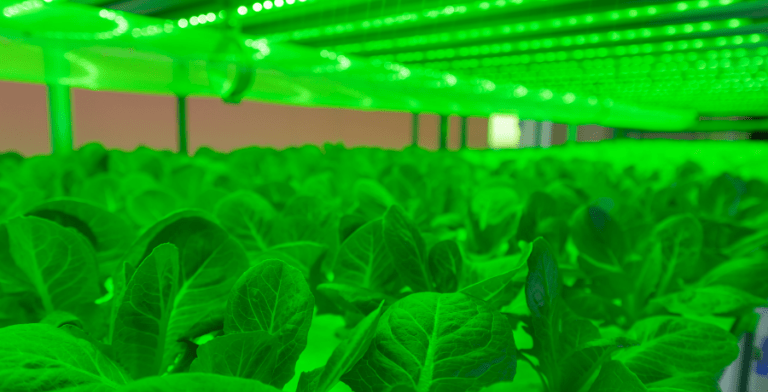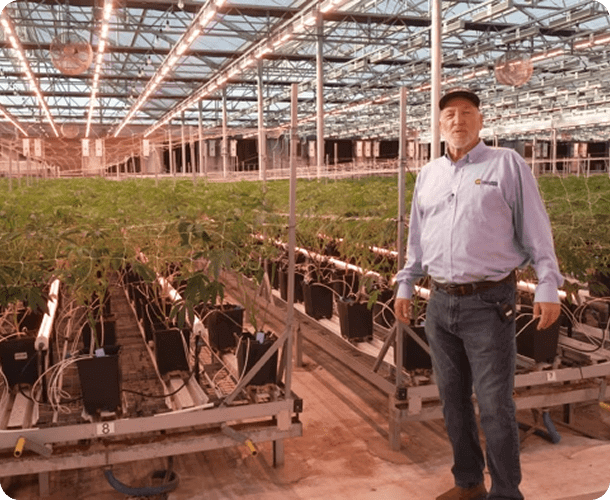Whether green light affects plant growth – and how – is a hotly debated topic among growers. While it’s commonly stated that plants do not absorb green light but only reflect it, this is not entirely true. Out of all the light on the visible spectrum, plants reflect green light the most and absorb it the least. However, the percentage of green light reflected is relatively small and the majority of green light is useful for photosynthesis.
This does not necessarily mean that green light is effective for plant growth. The topic has yet to be widely studied. While full-spectrum LED lights include green light, it’s unclear how useful green light is for stimulating plant growth. Below, we’ll break down what we know about the effects of green light on plant growth and when and how it should be used in the growth cycle.
Why use green lights?
Many colors on the light spectrum are used in a controlled environment to manipulate everything from a plant’s smell to its potency to its taste. Green lights, however, are often used for more practical purposes. Growers frequently use green LEDs to check their plants for things like pest infestations or damage during the dark cycle. Green lights mimic moonlight or shade, so they can be turned on without interfering with a plant’s night cycle.
When it comes to using green light for plant growth specifically, growers frequently use a combination of green light and other colors on the spectrum throughout the cycle (green light is a main component of white light). Again, however, green light is widely considered the least useful light for photosynthesis. It’s often used in conjunction with other colors. For example, some studies indicate that low intensity green light can enhance far red light.
Is green light harmful?
Possibly, although more research is needed. Some studies suggest that green light makes plants behave as if they’re growing in poor, shady environments. This could possibly stunt plant growth and development if green light is overused.
However, there is still a lot we don’t know about green light and how different colors on the light spectrum affect plants in general. A study conducted by Michigan State University found that blue light actually stunted plant growth more than green lights.
This is, of course, only one study. There is still a lot more research needed to determine whether green light is actually harmful to plants and at what stage in the growth cycle it’s safe to use. As with a light of issues surrounding plants grown under full-spectrum LED lighting, the verdict is out on how effective green light is for plant growth.
Are there any benefits to green light?
Again, the answer is possibly. Due to limited research, the benefits of green light – if any – are not widely understood.
Green light definitely has practical uses. Again, green light is often necessary to examine your plants throughout the grow cycle. If there are any issues – like a pest invasion – the sooner you know, the better. Green light allows you to check on your plants without disrupting the grow cycle.
However, some evidence indicates that green light has other beneficial effects on plant growth. Green light may better penetrate a canopy than other colors on the visible spectrum. This allows lusher growth on lower leaves, possibly leading to a better yield overall. In limited amounts, and used alongside other colors, green light could potentially create stronger, fuller plants.
The Bottom Line
There’s a lot we still need to learn about how light affects plant growth. The impact green light has on plants remains a controversial topic. Research is limited and further studies are needed to make any definitive statements on how green light affects your plants.
However, green light definitively reduces eye strain, allowing you to notice things like nutritional deficiencies, disease, or insect infestations and act accordingly. The ability to intervene in the event of such issues early is vital to your plant’s overall health. This is why having green LEDs is important (normally included in the white LEDs), even if you use them in very low levels throughout the grow cycle.
As for other potential benefits of green light, a lot remains to be learned. In the meantime, part of the excitement of LED lighting is the chance to experiment with different spectrums of light throughout the growth cycle. You can try tweaking your green light settings and see if it results in lusher lower leaves, for example. You may see success.
As always, California Lightworks is here to answer any questions you may have about growing. We’re always bringing you the latest in innovations in LED lighting to ensure growers of all levels can thrive. Feel free to contact us here if you have any questions.





